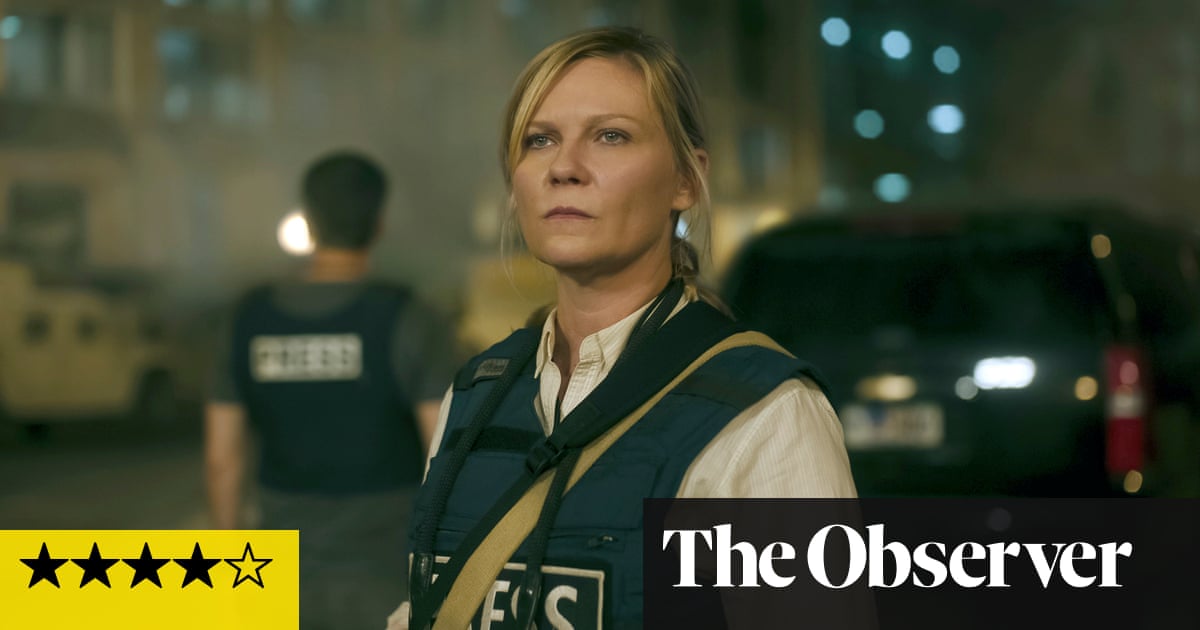A near-future US has turned its anger against itself; a new civil war is raging. As tracer fire whiplashes across the sky and the suburbs smoulder, a secessionist rebel faction known as the Western Front is drawing ever closer to Washington DC. Meanwhile, the president (Nick Offerman), barricaded in the White House, tries out the emphasis of his words as he rehearses for his latest televised address. He promises that the defeat of the rebels is imminent, adding: “Some are already calling it the greatest victory in the history of mankind.” There’s a whiff of Trumpian rhetoric here, but this is the only hint of real-world US politics in British writer-director Alex Garland’s searing dystopian war movie. Location notwithstanding, Civil War is perhaps best viewed not as an overt commentary on America today, but rather as a film about conflict.
Specifically, it’s about conflict as witnessed by war correspondents – the people who have seen enough of it around the world to have learned that the battleground is a common ground; that the same atrocities play out wherever there are grievances, guns and people prepared to point them at each other.
Frontline photographer Lee Smith (Kirsten Dunst) knows this all too well. The last thing she sees when she closes her eyes at night is a clip reel of the horrors that have played out in front of her camera lens during a career spanning several decades. She has been doing this long enough to know that making direct eye contact with death on a daily basis causes a certain part of the soul to atrophy. It’s a job that comes with a built-in moral grey area. It’s not the role of the war photographer, she explains to shell-shocked rookie snapper Jessie (Cailee Spaeny), to wrestle with ethical questions. It’s their job to record so that other people ask the questions. Even so, Lee can’t help but be struck by an existential conundrum that undermines her entire sense of professional purpose: if the warnings hardwired into the photographs she has taken over the years can be so readily ignored by her home country, what was the point of taking them?
But still, the lure of a big story has a way of quieting the doubts. And stories don’t get much bigger than the one that Lee and her writer colleague Joel (Wagner Moura) are pursuing next. They are heading on a circuitous and perilous journey across the country to DC to photograph and interview the president. Well, that’s the hope at least. In practice, it’s a foolhardy mission: journalists are regarded as enemy combatants in the capital and risk being shot on sight. But that doesn’t stop two other journalists, veteran New York Times reporter Sammy (Stephen McKinley Henderson) and aspiring photographer Jessie, from begging for a ride.
Together, the four make up a composite portrait of the war correspondent as an archetype. Lee is numb and cooly professional, any softness in her personality long since shuttered; thrill-seeking Joel is more gung-ho in his approach. Although elderly and out of shape, Sammy can’t countenance the idea of retiring. Jessie is horrified and terrified but has never felt so alive. Prolonged exposure to combat, the film suggests, all but writes itself into the DNA of an individual. Rather than other pictures about war journalism – Michael Winterbottom’s empathic Welcome to Sarajevo, for example, or the Marie Colvin biopic A Private War – Civil War evokes Kathryn Bigelow’s The Hurt Locker. These are people so bent out of shape by the horrors they witness that they find it hard to function away from the frontline.
after newsletter promotion
And in a way, you can understand the thrill. The combat sequences are executed with a full-throttle savagery; deft editing conveys the grim satisfaction of catching a moment of photographic truth amid the carnage. Particularly effective is the immersive use of sound: the thick and velvety silence in the aftermath of an explosion; the incongruous, fluting birdsong that heralds a scene of monstrous inhumanity (a sequence dominated by the formidable Jesse Plemons).
Stripping out any political context from the combat means that, for all its visual flair, Garland’s film falls some way short of more idea-driven pictures such as Alfonso Cuarón’s Children of Men. It does, though, capture chillingly the terrible, self-perpetuating momentum of war. A war that, in this case, has reached the point at which people no longer know what they are fighting for, only that they are fighting.







